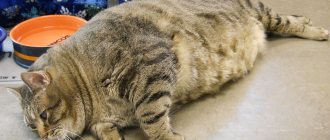Home » Cats and castration » Castration of Bengal cats
Castration of Bengal cats is a simple surgical procedure that can be performed in almost any veterinary clinic. It is done so that the cat is not aggressive towards its owners, does not mark the apartment and things with urine, does not experience attraction to females and does not suffer due to lack of communication with them.
In other words, Bengals are castrated in order to correct behavior, maintain health and increase active life expectancy.
Is it worth castrating a cat or all the pros and cons of the operation
Cat owners can be divided into two camps: some are supporters of castration of cats, while others call this procedure abuse of the animal. The final decision whether to deprive your pet of his testes or not to impair his ability to reproduce is up to you. It is worth knowing what advantages and disadvantages the operation has. The positive aspects of the procedure are the following points:
- castrated cats have a longer belly for about 2 years;
- having lost his testes, your ward will become less aggressive and will show friendliness towards people and other pets;
- castrated animals are easier to train;
- After castration, a cat stops marking its territory, which will prevent the appearance of an unpleasant odor in the house.
The operation also has negative aspects:
- it is performed under general anesthesia, which may pose a risk to the animal, especially if adult or old cats are subject to the procedure;
- There is always a risk that your patient will develop complications: bleeding, suture dehiscence and infection;
- After castration, a cat has an increased likelihood of developing urolithiasis and obesity, especially if the animal is not provided with proper care.
Possible complications
A classic cat castration operation lasts no more than 20 minutes. The recovery period is usually short; the pet recovers from anesthesia in an average day. Veterinarians recommend monitoring the animal for two days after surgery, monitoring how the cat behaves after castration, and not leaving it alone. This is due to the use of anesthesia, the side effects of which may appear during this time.
Some negative consequences of the operation are possible within 2-3 weeks after the intervention.
In what cases is it important to take your cat to the veterinarian:
- Bleeding. Occurs when the seams come apart. The blood flows in a thin stream and stains the fur. Treatment is surgical, so it is important to contact a veterinary clinic as soon as possible.
- Purulent inflammation. Possibly if the wound has become infected. Pus appears green, yellow, white, thick, with an unpleasant odor. Such a consequence is treated with antibiotics.
- Edema. It can develop if dirt or infection is brought into the wound. The scrotum swells, and the animal often experiences pain.
- Hernia. This is tissue loss that can occur, especially if the cat is older. The hernia is removed surgically; it is strictly forbidden to repair it yourself.
- Sepsis. Appears after a secondary complication after inflammation, hernia and other pathologies. At the same time, bacteria enter the blood and the temperature rises. Antibiotics are used for treatment.
- Pulmonary edema. The phenomenon is rare, but extremely dangerous. Due to heart failure, pressure in the pulmonary circulation increases, plasma enters the lungs, and oxygen supply decreases. The animal wheezes, coughs, and turns blue. If you don't get veterinary help quickly, the cat will suffocate.
At what age is it recommended to castrate a cat?
When determining the optimal age of an animal for surgery to remove the testes, it is worth considering the breed of the animal. This is why many owners are wondering when to castrate a Scottish cat, British cat or a representative of another breed. The body of each animal has physiological characteristics, taking into account which the optimal age of a cat for castration is determined.
- Burmese, Abyssinian and Siamese cats are recommended to be neutered between 5 and 6 months of age as they develop quickly.
- When deciding when to castrate a Scottish or British cat, it is worth remembering that representatives of this breed develop slowly. If they undergo surgery before 8 months, this is fraught with disproportion of the head to other parts of the body. The optimal age for removing the testes in this case is from 8 to 12 months.
- Representatives of other breeds and outbred cats are recommended to be neutered at 6–9 months.
It is not recommended to perform surgery on animals earlier than the above deadlines. Before this period, the cat’s organs are still forming, so removal of the testes can cause disruption of the urethra, which in turn will lead to the rapid development of urolithiasis or the appearance of adhesions in the ureter. In addition, at a very early age, a special, more complex operation will be required, since the testes are located in the abdominal cavity.
Owners should also know how to determine that a cat whose age is not precisely known needs castration. This is the problem faced by people who adopt an animal from the street. There are signs that indicate that it is time for the patient to undergo surgery:
- loss of appetite or complete refusal to eat;
- display of aggression towards owners or other pets;
- weight loss;
- restless sleep;
- frequent "singing";
- constant attempts to run away from home;
- the appearance of a strong odor after urination.
How long do Bengal cats live at home?
The ancestors of modern Bengals were wild Asian cats. For many years, poachers destroyed animals of this breed because of their valuable spotted skins, and the kittens were sold for pennies at spontaneous markets to European and American tourists. This is how the Bengal cat was brought to the USA and Europe.
In their natural environment, Bengals feed on fish and small rodents. They treat people with suspicion, but do not express aggression. At home, wild cats did not change their habits. They did not go into arms, were wary and did not agree to close contact, and at night they chose a secluded place for themselves.
At the end of the 70s, felinologists began breeding a new breed. She had to retain the unique “wild” coloring, add loyalty to the owner and the ability to live with people to her character. The main partners of Asian cats were Egyptian Mau and short-haired Burmese - these animals were better suited than others in terms of phenotype and disposition.
The first few generations of hybrids could not produce stable offspring - males remained infertile in 80% of matings, and kittens did not always inherit the parental coloring and short hair. However, breeders were able to overcome these shortcomings.
In 1991, a new breed of cat was first demonstrated in the TICA show ring - with leopard spots on a short, shiny coat and with the manners of ordinary domestic animals.
This is interesting! The life expectancy of the first Bengal cat hybrids barely reached 10 years. But later the breed gained stability, the group of breeding animals expanded, and the lifespan increased to 12-15 years.
Features of castration of adult cats
Sometimes owners decide to castrate an adult or old pet. Often, the operation is carried out on the recommendation of veterinarians due to the threat of the development of various ailments (diseases of the testes, prostate hyperplasia, aggressiveness, etc.). The main danger of surgery is the need to administer anesthesia, which can be very difficult for the pet to tolerate. To minimize the negative consequences of castration, it is recommended to take the following actions before surgery:
- contact a veterinary clinic for a thorough veterinary examination of your ward;
- perform a chest x-ray;
- conduct a laboratory test of the animal’s urine and blood;
- do an ultrasound examination of internal organs;
- If the veterinarian deems it necessary, you will need to undergo an examination by a cardiologist.
The absence of diseases in the animal will confirm the possibility of performing the operation.
The cat's toilet after the procedure
During the postoperative period, light-colored litter should be poured into the cat's litter box in order to notice possible bleeding in time. It is better to purchase a soft adsorbent to avoid irritation.
After castration, some owners put a small diaper on their pet, in which they have previously made a hole for the tail.
It may be that the cat does not have a toilet for a long time - neither big nor small, or the urine comes out little by little. This is quite normal.
Vaseline oil will help cope with constipation. It is poured into the animal’s mouth in a small amount; if after 20 minutes no negative reaction is observed, another 15-20 grams are given. After 3 hours, the animal's intestines should gently empty.
Why is it better to castrate young cats?
It is recommended to castrate cats before they reach puberty. If sex hormones begin to be released in your ward’s body, or he has at least one mating, it is possible that he will remember this and will show signs of attraction to females even after the testes are removed. Also, sometimes even after surgery the cat marks its territory. Castration helps to stop the production of sex hormones, but if even a small part of them has managed to enter the body, the animal can show signs of a full-fledged male.
Preparing a cat for castration
Owners should make sure that their cat is in good condition before castrating a cat. If the animal is active and there are no changes in its usual behavior, then you can safely go to the veterinarian. Before the operation, you should not feed the cat for at least 12 hours, which will make it easier for the cat to recover from anesthesia after castration. 3 hours before the upcoming surgery, you should not give your pet anything to drink. It is recommended to take a blanket with you to the veterinary clinic. Under anesthesia, your patient's temperature may drop, and it is better to cover him during sleep.
Factors affecting the health of the Bengal cat
For a hybrid breed, it is extremely important to follow certain rules that are dictated by the genetic nature of cats.
- Bengal cats are characterized by early puberty - all signs are formed by 8 months. By this time, the process of socialization and education should be completed. In the future, habits developed in the initial period of life are difficult to correct - the animal will be nervous and this will certainly affect the number of years lived.
- It is necessary to create conditions for active games at home. A Bengal cat living in an apartment is not able to develop harmoniously if it is deprived of the opportunity to splash out its energy.
- Long walks have a positive effect on animal health.
- Bengal cats are very active and play like little kittens until the end of their years. Punishing them for breaking vases or other pranks means subjecting them to serious stress.
Sometimes Bengals are transferred to aviary keeping. This solution does not contribute to increasing life expectancy. Cats quickly lose communication skills, stop communicating with people and die much earlier than their “indoor” counterparts.
Important! Bengal cats love to be around other animals. They especially like small dogs, with whom hybrids easily make friends.
Description of the stages of the operation
Castration of a cat is carried out in several stages:
- The veterinarian examines the animal to ensure it is in good condition. He takes temperature, checks heart function and breathing rate.
- After making sure that the cat is in good condition, the specialist administers medications that will provide support to the body after the procedure.
- The animal is given anesthesia for artificial sleep.
- The scrotum and vaginal membrane are cut, and the testes are removed. The veterinarian applies a ligature to the spermatic cord, which will prevent bleeding, and removes the testes.
- At the last stage of the operation, suturing is performed. Some clinics practice a seamless method of performing the operation. In this case, you will not have to visit the veterinarian again to remove the stitches.
What is it and how is it done?
Before considering how cats tolerate castration and other nuances of the intervention, we should dwell on the definition and types of manipulation.
During the procedure, the male’s testes are not simply removed, as is commonly thought, but the animal’s sexual function is also stopped, so different methods are used:
- Surgical method - performed through surgery. During it, the doctor opens the animal’s scrotum, removes the testes and ligates the canals.
- Medical sterilization. An implant is sewn under the animal’s skin, releasing drugs that suppress sexual instincts. The procedure is expensive, but is considered the safest.
- Chemical castration. In this case, substances are introduced into the testes that kill glandular tissue, which is subsequently replaced by connective tissue.
- Radiation sterility. In this case, the testes are placed under a source of gamma radiation. The method is quite simple, but the appropriate equipment is rarely found in clinics.
So, not every case requires a scalpel. The available choice of methods allows you to sterilize even old pets without risking their health and life. The veterinarian decides which castration is best for a cat, taking into account the age, health status of the animal and the capabilities available at the clinic.
In our country, they most often resort to the classical method of surgery. The reasons for this are the simplicity and cost-effectiveness of the technique. Let's dwell on it in more detail.
How much does it cost to castrate a cat?
It is impossible to indicate exactly how much it will cost to castrate a cat. The price depends on the location of the operation (in the clinic or at home), and the fees for the services of the selected veterinarian. The cost of services in veterinary clinics can range from 220 to 1600 hryvnia. Castration of a cat at home will be more expensive. In this case, you can select from the list provided the services that you think the veterinarian should provide:
- calling a specialist to your home;
- carrying out castration;
- recovery from anesthesia;
- use of a dropper;
- administration of antiviral serum.
Naturally, the more services you choose, the more expensive the procedure will be.
How mating occurs among Bengals: selection of a partner, mating technique
The Bengal cat is a rather difficult breed to breed. The species was shaped by specialists over many years - certain genes were fixed, others were eliminated. Competent selection of partners requires extensive knowledge, experience, understanding of what an ideal Bengal cat should be like and what genes are responsible for this. And if the owner of a Bengal cat is not a professional breeder, for consultations in selecting a groom, it is better to contact the nursery or club where the pet was purchased. The standard ad “looking for a Bengal cat for a kitty” may be the wrong step. The choice of a pair depends on several important parameters, and the color and type of tabby are not the most important ones. You need to look for a mating partner not only who is outwardly beautiful, affectionate, healthy, but also one who meets the standard. Even not very noticeable flaws - pale spots, small vertical stripes, short legs, a light body - indicate that the cat carries non-ideal genes, and the litter from it may deviate even further from the standard.
Features of mating Bengal cats
Now professionals allow mating of Bengals exclusively within the breed. The appearance of mixed breeds, for example, the mating of British and Scottish cats with Bengal cats, which has become fashionable, is not welcome. Of course, no one can prevent the owner from crossing his pet with another breed, but the offspring will not be considered Bengals. So, to the question that appears on the networks, whether it is possible to breed a Scottish cat with a Bengal (or a Bengal with a Scotsman or a Briton), official felinology answers with a categorical no.
The only exception is the permission to breed Bengal cats with their ancestors - wild Asian leopard cats, in order to refresh the genes, introduce interesting new qualities or strengthen existing ones. Such work is possible in large specialized nurseries; in private, few people will be able to find a wild animal for mating.
How is the mating done?
The mating season must be planned on the cat's territory - the most natural option, since the male feels more confident in his home. The cat is left with the groom for several days - it is advisable that the act of mating be repeated. How many days the mating will last depends on the animals themselves. Sometimes they take several days to get used to it, get to know each other, and sometimes the process is completed immediately, and this is also correct. One of the signs of successful mating is a noticeable change in the behavior of the female - she calms down, stops rubbing and meowing. An ultrasound scan after two weeks can indicate the success of the case with confidence. Born Bengal kittens are the property of the owner of the female, and the owners of the cat that was crossed with her receive either payment or a “maintenance” kitten. If it turns out that the cat did not become pregnant, the mating is repeated in the next cycle of her readiness (usually the mating with the same cat is already free).
Having conceived the continuation of the cat family, the owners must check the pedigree of their pet and partner - titled purebred parents, the presence of all documents and vaccinations are very desirable. It is worth inquiring about the type and fate of previous litters - older children from a parent or parent, then the owner will have more confidence in the purebred offspring without genetic problems.
Read all about the Bengal breed in the Main article
How to care for your pet after surgery
Special attention from owners is required when anesthesia wears off after castration of a cat. During this period, owners need to show love and care to their ward. You need to carefully ensure that the cat does not climb into high places (chair, table, bed, window sill, etc.). In a state of coma, he may fall, which is why the stitches often come apart. It is recommended to keep your pet in a special collar for a couple of days.
If a post-operative wound does not heal well or fluid begins to leak from it, you should immediately contact a veterinarian for an examination. Such symptoms may indicate the development of an infection that requires urgent treatment. You will need to visit the clinic if your pet continues to have a high fever, decreased appetite, or is lethargic.
Owners should also remember that after castration, their pet’s metabolism slows down. This can cause the animal to develop obesity. That is why it is worth knowing what to feed a neutered cat. A properly selected diet will also protect your pet from developing urolithiasis. It is very important to ensure that the animal always has free access to fresh water.
Famous long-lived Bengal breeds
Bengal domestic cats are a very young population. In TICA, the Bengals received champion status in 1992, FIFe included them in the register another 8 years later, and CFA recognized them only in 2020. The hybrids have not yet acquired their own “honorary pensioners,” although one of the castrated cats in the United States has already passed the 20-year life mark.
But the exotic appearance of spotted Bengal cats appealed to many modern stars of politics, sports and show business. Celebrities are happy to show off animals with leopard fur and spare no expense on their maintenance.
Model Naomi Campbell, actress and director Sofia Coppola, singer and designer Victoria Beckham, English writer and aristocrat Lord Jeffrey Archer and many other famous names posed with the Bengals.
Bengal cats are now most common in the United States. This is where their pedigree line began, the most rapid development of the population is taking place, and this is where reports come about how and how long they live at home or in a free enclosure. But even in Russia, the first breeders are already offering kittens of their own breeding.
The only obstacle to the mass distribution of a beautiful unique cat is its cost. Bengals are still consistently in the lead in the TOP list of the most expensive breeds.











